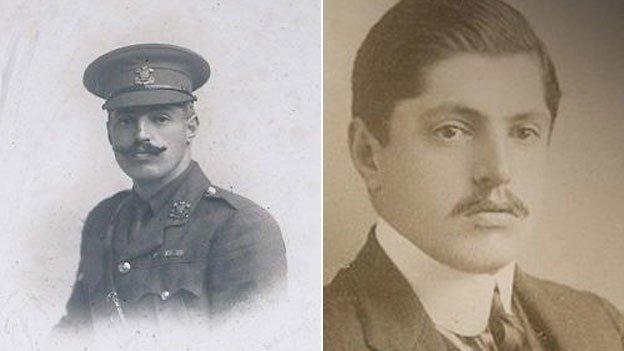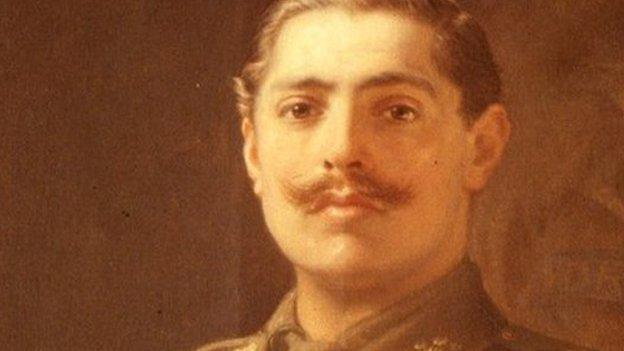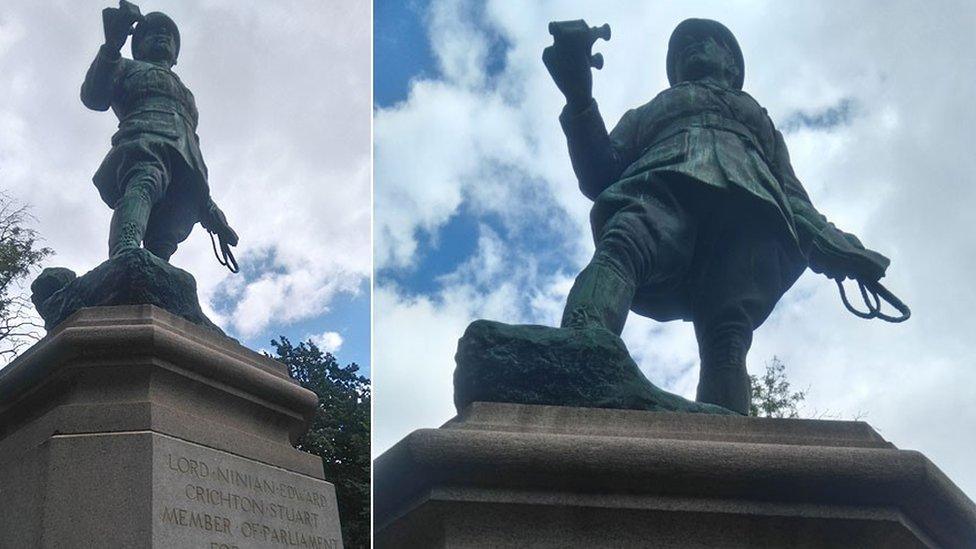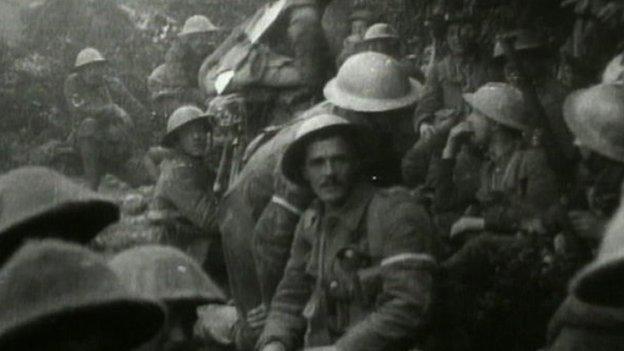World War One: Death of Lord Ninian Crichton Stuart MP marked
- Published

Lt Col Ninian Crichton-Stuart in his uniform in 1914 and as an MP
The 100th anniversary of the death of Wales' only MP to be killed in World War One has been marked in Cardiff.
Lord Ninian Edward Crichton-Stuart was shot in the head as he rallied his troops serving with the 6th Battalion Welsh Regiment on 2 October 1915.
The 32-year-old lieutenant colonel had been elected as Unionist MP for Cardiff in 1910 but was re-called to serve after the outbreak of the war.
A wreath was laid at his statue at Gorsedd Gardens in the city centre.
Crichton-Stuart, the second son of the Marquess of Bute, was one of 22 MPs to die during the war. Another 24 members of the House of Lords were killed.
As an MP, Crichton-Stuart was known for his hard work in the constituency - which then stretched to Cowbridge and Llanstrisant - and stood as a guarantor for £90 to Cardiff City Football Club.
Wearing a bowler hat, he ceremoniously helped kick off the first match at the club's new stadium in 1910 which was named Ninian Park in his honour.
Crichton-Stuart had served as a lieutenant with the Scots Guards until 1907 but then moved to Cardiff to pursue a career in politics.
'Marooned'
After being elected as an MP, his interests in the House of Commons were mainly around the Army and Navy, while back in Wales he became commanding officer of the 6th Welsh Regiment in 1911.
When war was declared, the regiment - made up of volunteers from Swansea and Neath - became the first Welsh territorial regiment to head for France.

A painting hangs in Cardiff Castle, which was owned by the Bute family
His granddaughter Marietta Crichton-Stuart has researched his life , externaland visited where he fought and died in the second phase of the Battle of Loos.
One story about his death is that the he was leading his troops to save a soldier left behind during a retreat; another version is more mundane.
"The battalion were marooned in this section of trench and had run out of ammunition and were under attack from the Germans on three sides," says Marietta.
"My grandfather died on the fire step of the trench directing the machine gun to pick out a line of fire.
"This was in the days before steel helmets and he was shot in the head and died instantly."
Crichton-Stuart is buried in the town of Bethune.
The 6th Battalion suffered heavy losses during the war, with only 30 survivors from the 842 men who set out. But there were still veterans' reunions in Swansea until the late 1960s.
Marietta's father Michael was only six months old when Crichton-Stuart was killed. He later joined the Scots Guards himself and named one of his sons Ninian.
Although Ninian Park has now gone, the name is still remembered in a school and streets in the Grangetown and Riverside areas.
His name is also on the Grangetown war memorial.

The wreath was laid at the statue to Lord Ninian in Cardiff at 1100 on Friday
"He is someone I admire enormously - his brother told my dad that Ninian had the common touch and could get on with anybody," said Marietta.
"We've copies of letters, telegrams received after his death which came from people from all walks of life and show someone who had made an impact on a lot of people. He was a very thorough constituency MP and was a people-person.
"He had a very good sense of humour, and the letters of condolence the family received range from Mrs Lloyd George to a Cardiff organ grinder."
Marietta will also be at Cardiff Castle on Friday - where her grandfather's portrait hangs - and will be giving a lecture there next week, before ceremonies in France.
- Published10 August 2015

- Published3 May 2015

- Published6 January 2015
